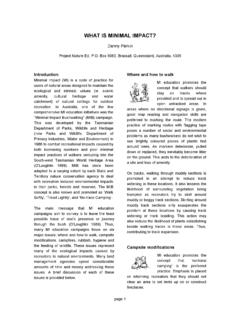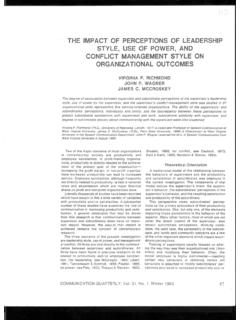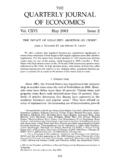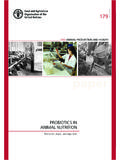Transcription of EY - The economic impact of the Premier League
1 The economic impact of the Premier League1 Executive summaryThe primary role of the Premier League is to organise the football competition between the 20 Clubs that make up the revenue terms, it is now the third largest League in the world, behind the US Major League Baseball and National Football League (American Football).Each Premier League match is watched by thousands of fans, who travel the country to follow their team, and millions more on television. This interest helps to generate a range of revenues; including ticketing, merchandise and broadcast. In particular, the sale of broadcast rights has been one of the most significant revenue streams for the Premier League and Clubs. This summary report presents the estimated economic contribution of the Premier League in the 2013/14 season. Also included are a number of other key performance metrics which have been updated to reflect the most recent available information. These estimates represent just a part of the economic impact of the Premier League and its Clubs.
2 There are a range of other industries ( , tourism, broadcasting, gambling etc.) that are directly and indirectly supported by the , the impact of the Premier League and Clubs goes beyond the economic impact described. For example, investment in facilities and the community programmes supported by the Premier League in schools and deprived areas has reached significant scale. Building on the appeal of the UK s most popular sporting competition, these programmes are helping to realise a range of health, education and social benefits through increased participation in sports and development of skills. taxes to the Exchequer Value Added to GDP 722minternational broadcasting revenueOver100,000jobs in the UKIn the 2013/14 season alone, the Premier League and its Clubs contributed: The full EY economic impact Analysis of the Premier League is available to download at: 2 The economic impact of the Premier Premier League stadium utilisation544artificial grass pitches built to dateOver546,000young people engaged on community projects in 2014/15 225m in football solidarity payments The success of the Premier League , which is grounded in the quality of the football competition, has created a cycle of growth.
3 This should help ensure that the significant contribution to the UK economy and society will continue to increase in years ahead. Mark Gregory, Chief Economist, EY We help create the conditions for Clubs to succeed. Quality football in full and vibrant stadiums delivers results for the whole game and its wider communities. Richard Scudamore, Premier League Executive Chairman3 The success of the Premier League drives a cycle of growthThe Premier League competition consists of 380 matches played over a nine month season and sees each Club play each other home and away. It is run on a commercial basis and generates a range of revenues including ticketing, merchandising and broadcast revenues that flow to Clubs in the Premier League and beyond. These revenues have enabled Clubs to invest in all aspects of the game including their squads, stadia and training facilities which in turn has generated greater interest in the competition from football fans in the UK and appeal of Premier League football to both domestic and global audiences has helped to increase the inward economic impact of the competition by attracting international tourism, broadcasting revenues and foreign investment.
4 Worldwide, the Premier League is available in 185 countries and broadcast to an estimated 730 million and invest in stadia, facilities and talentGenerate increasing demand and interest in the Premier LeagueDistribute equitably and use influence for wider football development and CSRC onvert the interest into commercial success and sustainable growthThe cycle of growthBroadcasting rights valueTotal (millions)1187/8840+92 broadcasting revenue 722m2013/14broadcast in 185 countries2014/15 Average attendance 36,691 2013/14 Stadium utilisation 2013/14 Televised games reach 730mhomes2014/154 The economic impact of the Premier LeagueThe growth in popularity of English football has been based on the ability of the Premier League and the Clubs to realise the value of the football competition. Each of the main revenue streams, including ticket sales, merchandise, sponsorship, advertising and additional uses of the stadium, as well as the sale of broadcast rights, gain from a strong League competition that reaches a wide the growing popularity of English club football and the emergence of the pay TV market, the Premier League is able to achieve broadcast revenues that were significantly greater than previous levels.
5 By way of illustration, in 1992/93 (the first season of the Premier League ) total broadcasting rights sold for over 40 million per year, which compares to the 11 million achieved by the Football League for the 1988/89 season; in 2013/14 total rights were worth over the last 20 years, this growth cycle has seen the Premier League develop football into a sport that is more attractive and accessible to the general 2014/15 of all the individual people who attended a Premier League match:26% were female17 %051015202530123456789101112131415161718 BundesligaTop: : : 1:20102030405060708090100123456789101112 1314151617181920La LigaTop: : : 1 LeagueTop: : : 1 ATop: : : 1 40%Broadcasting revenues distributed to Premier League Clubs in 2013/14 were greater than that in the Bundesliga, La Liga and Serie A. It is also more equitably distributed, with the Club finishing top of the Premier League receiving times that of the Club finishing bottom.
6 This compares with two times as much in the Bundesliga and almost seven times as much in La from black, asian or minority ethnic groupswere aged 18-34of season ticket holders were under-165 The growth of the Premier League supports investment at all levelsThe global demand for the Premier League drives higher broadcasting revenuesThe Premier League is the largest of the big five European leagues in terms of 2013/14, the Premier League Clubs earned billion from all broadcasting rights, which is more than the amount received by the next three largest European leagues combined. Of particular note is the proportion of the Premier League s broadcasting revenue which is from international providers. At around 722 million, the international broadcast revenues received by the Premier League in 2013/14 were greater than the total (domestic and international) broadcast revenue individually generated by Ligue 1, Serie A, the Bundesliga and La Liga in that year.
7 Of all the major European leagues, the Premier League has the most equitable ratio in terms of the amount received by the top and bottom revenue earners. Stadium utilisation and average attendance across the European big-five leaguesAttendance at Premier League matches has grown from an average of 21,125 in the 1992/93 season to 36,691 in 2013/14, an increase of 74%. The stadium utilisation rate in the Premier League increased from in the 1992/93 season to in 2013/14, which means that games are played in front of capacity or near capacity ,00015,00020,00025,00030,00035,00040,000 45,000 PremierLeague199220131992201319922013199 2201319922013 BundesligaLa LigaSerie ALigue 1 Attendance95%91%64%59%70%Utilisation6 The economic impact of the Premier LeagueWith increasing revenue streams, Clubs continue to invest in their facilitiesSince the beginning of the Premier League , many Clubs have made substantial investments in new stadium facilities. Indeed, of the 20 Clubs that played in the Premier League in the 2013/14 season, all have embarked upon stadium upgrades including new stands or refurbishments whilst eight have moved to entirely new facilities.
8 Each of these represents a substantial programme of private-sector capital in player performance supports the future of the gameThe Premier League s Elite Player Performance Plan (EPPP) aims to develop more and better home grown players, with a 340 million commitment over a four year period for youth development across the top four divisions. A requirement of EPPP funding is a commitment by clubs to support all aspects of a player s development. In order to achieve this, many Premier League Clubs are investing in their Academy way of one example, in 2012/13, Stoke City opened their new 7 million Clayton Wood training facility. This investment has transformed Clayton Wood from four Portakabins and some grass pitches into a state-of-the-art facility. 390mspent by Arsenal on the Emirates Stadium 27m spent by Swansea City on the Liberty Stadium 32m spent by Southampton on the St Mary Stadium 15m spent by Stoke City on the Brittania Stadium 42mspent by Manchester United on their 2nd Tier expansion 260mLiverpool s main stand redevelopments as part of a wider regeneration programme7 The Premier League generates a range of economic benefits for the UKCapturing the direct, indirect and induced effectsThe approach to estimating the economic impact of the Premier League captures not only the direct economic impact resulting from the Premier League and Clubs, but also the additional economic activity that occurs through their supply chains ( the indirect impact ) and additional activity that occurs from employee spending ( the induced impact ).
9 Capturing the induced impact is perhaps of particular importance in estimating the economic impact of the Premier League Clubs given that a large proportion of Club spending is on wages and salaries. The game of football is of considerable economic , social and cultural significance to the UK. During the football season, thousands of fans travel the country to follow their team, while millions more watch live games and highlights on television and, increasingly, online. The growing interest in the Premier League from home and abroad reflects continued investment in the Clubs, stadia, players and across media outlets. This, in turn, generates significant economic activity in the UK, supporting jobs across a range of sectors and generating tax receipts to League ClubsFootball solidarityCommunities and good causesWider economic benefitsOutputGross Value Added (GVA)EmploymentTax receiptsLocal and national tourismInternational exports and recognitionSupported industriesParachute paymentsSolidarity payments to Championship/Football LeagueNon- League supportClubs as hubs of communitiesInvesting in facilitiesSports participation and educationInternational developmentThe Premier League8 The economic impact of the Premier LeagueThe Premier League generates significant returns to GovernmentThe Premier League and Clubs contributed billion to the public finances in 2013/14 when direct, indirect and induced effects are accounted Premier League contributed an estimated 88 million in taxation in 2013/14.
10 This included direct contributions for National Insurance and employee PAYE of 5 million and indirect and induced effects totalling 58 million and 25 million respectively. Meanwhile the Clubs contributed an estimated billion in 2013/14 through business rates (on all facilities and stadia), corporation tax, National Insurance contributions, player and staff PAYE as well as directly attributable VAT. This includes a direct contribution of billion and billion and billion of indirect and induced contributions. tax receipts 941min employee PAYETax receipts equivalent to93,000police constablesPremier League Club players contributed 891m in taxes in 2013/14 E 941mEmployeeNIC 276mEmployerNIC 475mCorporation Tax 298mBusiness Rates 25mVAT 390mTota l Tax contribution 2,407m bnTotal tax contributionsThe tax numbers presented above do not sum to the total provided due to rounding of numbers9 Employment supported by the Premier League s activityThe Premier League supports a broad range of employment opportunities across the economyThe Premier League and its Clubs supported over 100,000 full time equivalent (FTE) jobs in the UK in 2013/14.


















